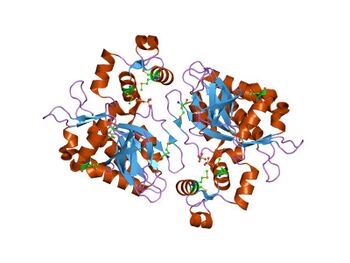Biology:Inositol polyphosphate kinase
| Inositol polyphosphate kinase | |||||||||
|---|---|---|---|---|---|---|---|---|---|
 Structure of the Inositol 1,4,5-trisphosphate 3-kinase A protein. | |||||||||
| Identifiers | |||||||||
| Symbol | IPK | ||||||||
| Pfam | PF03770 | ||||||||
| InterPro | IPR005522 | ||||||||
| SCOP2 | 1tzd / SCOPe / SUPFAM | ||||||||
| |||||||||
Inositol polyphosphate kinase (IPK) is a family of enzymes[1] that have a similar 3-dimensional structure. All members of the family catalyze the transfer of phosphate groups from ATP to various inositol phosphates. Members of the family include inositol-polyphosphate multikinases, inositol-hexakisphosphate kinases, inositol-trisphosphate 3-kinases, and inositol-pentakisphosphate 2-kinase, which is more distantly related to the others[2][3]
The discovery of the IPK family occurred in 1999, when a combination of biochemistry, sequence analysis, and genetics led to the classification of a family of inositol polyphosphate kinases. [4][5] In 2005, the first crystal structures of an IPK family protein were published for ITPKA.[6][7]
Subsequently, structures of the inositol polyphosphate multikinase and various IP6 kinases have expanded our structural understanding for how each enzyme catalyzes its specific reaction(s).
References
- ↑ "Kinase Family IPK - WikiKinome" (in en). http://kinase.com/wiki/index.php/Kinase_Family_IPK.
- ↑ "InterPro". https://www.ebi.ac.uk/interpro/entry/IPR005522.
- ↑ "Inositol 1,3,4,5,6-pentakisphosphate 2-kinase is a distant IPK member with a singular inositide binding site for axial 2-OH recognition.". Proc Natl Acad Sci U S A 107 (21): 9608–13. 2010. doi:10.1073/pnas.0912979107. PMID 20453199. Bibcode: 2010PNAS..107.9608G.
- ↑ "Synthesis of diphosphoinositol pentakisphosphate by a newly identified family of higher inositol polyphosphate kinases.". Curr Biol 9 (22): 1323–6. 1999. doi:10.1016/s0960-9822(00)80055-x. PMID 10574768.
- ↑ "A role for nuclear inositol 1,4,5-trisphosphate kinase in transcriptional control.". Science 287 (5460): 2026–9. 2000. doi:10.1126/science.287.5460.2026. PMID 10720331. Bibcode: 2000Sci...287.2026O. https://pubmed.ncbi.nlm.nih.gov/10720331.
- ↑ "Structure of a human inositol 1,4,5-trisphosphate 3-kinase: substrate binding reveals why it is not a phosphoinositide 3-kinase.". Mol Cell 15 (5): 689–701. 2004. doi:10.1016/j.molcel.2004.08.004. PMID 15350214.
- ↑ "Crystal structure of the catalytic core of inositol 1,4,5-trisphosphate 3-kinase.". Mol Cell 15 (5): 703–11. 2004. doi:10.1016/j.molcel.2004.08.005. PMID 15350215.
 |

